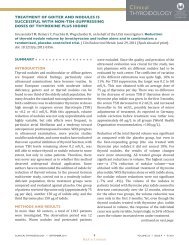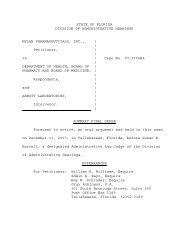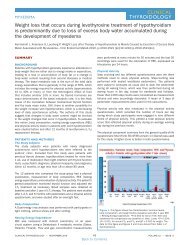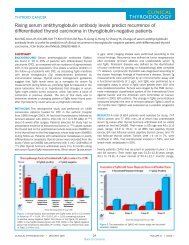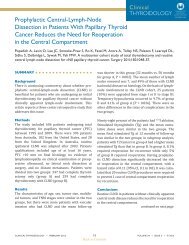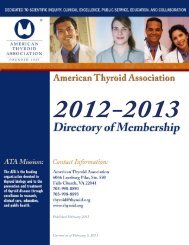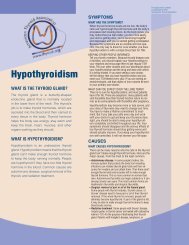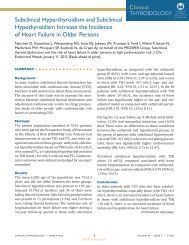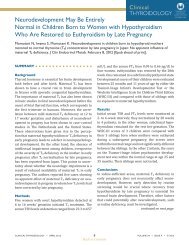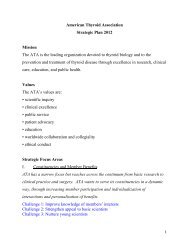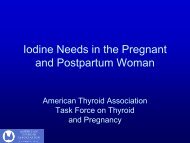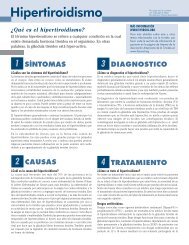Clinical Thyroidology February 2013 Entire Issue - American Thyroid ...
Clinical Thyroidology February 2013 Entire Issue - American Thyroid ...
Clinical Thyroidology February 2013 Entire Issue - American Thyroid ...
You also want an ePaper? Increase the reach of your titles
YUMPU automatically turns print PDFs into web optimized ePapers that Google loves.
Subacute <strong>Thyroid</strong>itis Is Treated Effectivelyby a Low Dose of PrednisoloneKubota S, et al.ANALYSIS AND COMMENTARYThis study is a valuable clinical contribution to thyroidologybecause it is the first study that analyzed theresponse to corticosteroid therapy in a large populationof patients with subacute thyroiditis. Treatmentwith about half of the usually recommended steroiddose was effective in ameliorating the disorder in 80%of patients within 8 weeks. Because the mean weightof these Japanese patients, mainly women, was only55 kg, the 15-mg dose (0.27 mg per kilogram) wouldprobably be equivalent to at least 20 mg of prednisonein a Western population.The late Robert Volpé was an expert in this disorderand wrote an excellent review of its management(1). Volpé advocated a dose of 40 mg of prednisone,tapering it over 6 weeks. He noted that about 20%of patients will have a recurrence, necessitating therestoration of a higher dose, similar to the findings ofthe current report. Volpé expressed a preference forearly initiation of steroid therapy, which is also thepreferred therapy of the authors of this paper ratherthan initiating therapy with NSAIDs, as recommendedby the guideline 96 of the ATA, before using prednisonetherapy (2). The 6-week duration of corticoste-roid therapy in this study is somewhat longer thanthat reported with empirical therapy of 49 patientsin Minnesota with tapering of 40 mg of prednisone in7 days and continuation of the reduced dose for only30 days (3). However, two thirds of the group alsoreceived other therapy, probably NSAIDs.It is interesting that the patients with higher thyroidhormone levels had faster restoration of normallevels with the glucocorticoid therapy and were morelikely to be in the short-term medication group (6weeks). The explanation suggested by the authorsis that these patients had more destruction of theirthyroid glands as compared with those who requireda longer duration of therapy for resolution of thedisorder. Presumably, the destruction reversed morequickly because the maximum destruction occurredat an earlier time—a unique hypothesis.It is interesting that the authors followed the guidelinesof the Japan <strong>Thyroid</strong> Association (www.japanthyroid.jp/doctor/guideline/english.html#akyuu)and did not perform a radioactive iodine–uptake testto confirm the diagnosis. This is another instance inwhich ultrasonography is replacing the use of radioisotopesin clinical diagnosis.References1. Volpé R. The management of subacute(DeQuervain’s) thyroiditis. <strong>Thyroid</strong> 1993;3:253-5.2. Bahn Chair RS, Burch HB, Cooper DS,Garber JR, Greenlee MC, Klein I, Laurberg P,McDougall IR, Montori VM, Rivkees SA, RossDS, et al. Hyperthyroidism and other causes ofthyrotoxicosis: management guidelines of the<strong>American</strong> <strong>Thyroid</strong> Association and <strong>American</strong>Association of <strong>Clinical</strong> Endocrinologists. <strong>Thyroid</strong>2011;21:593-646. Epub April 21, 2011; doi:10.1089/thy.2010.0417.3. Fatourechi V, Aniszewski JP, Fatourechi GZ,Atkinson EJ, Jacobsen SJ. <strong>Clinical</strong> features andoutcome of subacute thyroiditis in an incidencecohort: Olmsted County, Minnesota, study. J ClinEndocrinol Metab 2003;88:2100-5.CLINICAL THYROIDOLOGY • FEBRUARY <strong>2013</strong> 44 VOLUME 25 • ISSUE 2 • © <strong>2013</strong>Back to Contents



